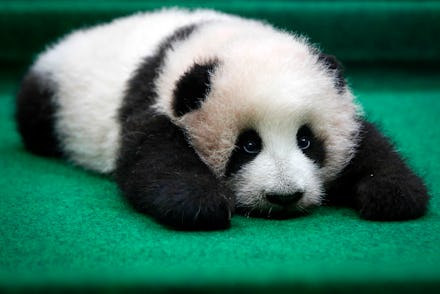Video of Twin Panda Cubs at Toronto Zoo Is Cutest Thing on the Internet Today

Look at these baby pandas. Look at their tiny, clawed panda feet and their little panda stretches and their just-now-opening panda eyes. After eight weeks on panda watch, the Toronto Zoo reports that its twin giant panda cubs — which were born to mama Er Shun on Oct. 13 — are just now prying open their peepers. Because they "are very vulnerable at this size," the zoo is keeping them inside the "maternity area" of the Giant Panda House, safely out of the public eye, until February or March.
The twins are being twin-swapped in and out of Er Shun's care, the zoo reported on its Giant Panda Cubs blog, which means that "one baby is left with the mother and the keepers switch the twins every few hours so each one gets care and milk directly from mom." On Dec. 8, the zoo assured visitors that "the only time the cubs are not with mom is when she is eating bamboo," which is critical for her continued lactation.
The great panda debate — argument for extinction: Bamboo consumption may also be one of the problems with pandas as a species, one of the talking points in a debate surrounding the ecological viability of the giant panda. According to controversial wildlife expert and television presenter Chris Packham, "The panda is a species of bear that has gone herbivorous and eats a type of food that isn't all that nutritious, and that dies out sporadically," as he told the Guardian, citing the panda's small-and-shrinking Chinese habitat, their susceptibility to disease and the difficulty of breeding the bears in captivity as reasons why they should be allowed to go extinct. Exorbitant amounts of money are spent on keeping the panda alive, he says, "when we know that the best thing we could do would be to look after the world's biodiversity hotspots with greater care. ... So maybe if we took all the cash we spend on pandas and just bought rainforest with it, we might be doing a better job," he said in the Guardian interview.
The argument for preservation: World Wildlife Fund scientist Mark Wright responded to Packham in the Guardian interview, saying that that the panda is one of many species "that live in a narrowly defined habitat" and that would survive if we preserved the habitat. "In terms of its biodiversity and the threats it faces ... the part of China where pandas live should be on the preservation list anyway," Wright said. Preserve the habitat, preserve its species, of which there approximately 1,600 members left in the world. He added that pandas "are an extraordinarily good vehicle for the messages we want to put out on habitat conservation" because people "can relate to them. And it does make a difference."
Because look at those baby pandas, tugging at the heartstrings of conservationists and zoo-goers alike. Their tiny panda feet and their little panda stretches and their generally accepted status as adorable-to-humans may be their best bet for survival.